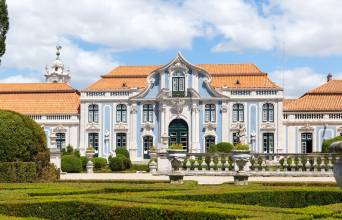Queluz National Palace

Palace of Queluz The Palace of Queluz. The "Ceremonial Façade" of the corps de logis designed by Mateus Vicente de Oliveira. The Palace of Queluz (Portuguese: Palácio de Queluz, Portuguese pronunciation: [kɛˈɫuʃ]) is an 18th-century palace located at Queluz, a city of the Sintra Municipality, in the Lisbon District, on the Portuguese Riviera.
One of the last great Rococo buildings to be designed in Europe, the palace was conceived as a summer retreat for Dom Pedro of Braganza, later to become husband and then king consort to his own niece, Queen Maria I. It served as a discreet place of incarceration for Queen Maria as her descent into madness continued in the years following Dom Pedro's death in 1786.
Following the destruction by fire of the Ajuda Palace in 1794, Queluz Palace became the official residence of the Portuguese prince regent John VI, and his family and remained so until the royal family fled to the Portuguese colony of Brazil in 1807 following the French invasion of Portugal.
Work on the palace began in 1747 under Portuguese architect Mateus Vicente de Oliveira. Despite being far smaller, the palace is often referred to as the Portuguese Versailles. From 1826, the palace slowly fell from favour with the Portuguese sovereigns. In 1908, it became the property of the state.
Following a serious fire in 1934, which gutted one-third of the interior, the palace was extensively restored, and today is open to the public as a major tourist attraction. One wing of the palace, the Queen Maria I Pavilion, built by Manuel Caetano de Sousa, is currently used as Portugal's official state guest house, allocated to foreign heads of state.
